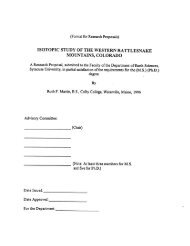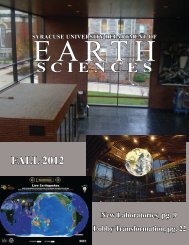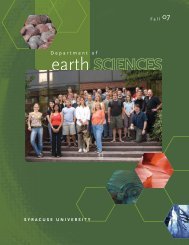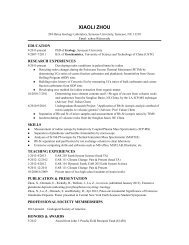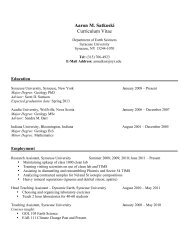alumni reception - Syracuse Universe Department of Earth Sciences ...
alumni reception - Syracuse Universe Department of Earth Sciences ...
alumni reception - Syracuse Universe Department of Earth Sciences ...
Create successful ePaper yourself
Turn your PDF publications into a flip-book with our unique Google optimized e-Paper software.
illion year time-scales. As a potassium-bearing<br />
mineral, jarosite is a potential chronometer for<br />
dating the presence <strong>of</strong> liquid water near the surface<br />
<strong>of</strong> Mars. To prepare for future Mars sample return<br />
missions where Martian jarosite will be analyzed, we<br />
are looking to understand how to properly interpret<br />
measured ages in the context <strong>of</strong> Mars geology.<br />
Additionally, we have completed fieldwork in<br />
the Bighorn Basin <strong>of</strong> Wyoming where we collected<br />
a series <strong>of</strong> jarosite, hematite, and goethite-bearing<br />
samples from the Paleocene Fort Union and Eocene<br />
Willwood Formations. These units consist <strong>of</strong><br />
ancient paleosols (soils preserved in the rock-record)<br />
that underwent a<br />
post-depositional<br />
environmental<br />
transition from<br />
water-saturated to<br />
drained and arid;<br />
very similar to that <strong>of</strong><br />
the Burns Formation<br />
at Meridiani Planum<br />
on Mars. As a nearsurface<br />
geological<br />
analog for Mars, we<br />
Joe intently looking for Martian<br />
analogs in Wyoming.<br />
are investigating the<br />
possibility <strong>of</strong> dating<br />
the transition from<br />
wet to dry, and then apply the methodology to future<br />
Mars missions. Ability to construct a time-scale for<br />
the past wet environments on Mars has important<br />
implications for the possibility <strong>of</strong> life to have<br />
developed on the planet.<br />
In the background <strong>of</strong> these studies we are<br />
gearing up to run some simple experiments seeking<br />
to gain insight towards questions about the degree to<br />
which basalt outgases and re-equilibrates atmospheric<br />
argon when melted and recrystallized, if there is a<br />
mantle contribution toward excess argon in highpressure<br />
amphibole, and what is the mantle argon<br />
signature recorded in various ultramafic rocks from<br />
the Late Paleozoic through the Mesozoic.<br />
James Metcalf<br />
I had another full year working as the noble<br />
gas thermochronology lab manager and research<br />
associate. This year marks the end <strong>of</strong> the NSF grant<br />
Paul Fitzgerald and Suzanne Baldwin received that<br />
I was originally hired on, investigating along- and<br />
across-strike patterns <strong>of</strong> uplift and exhumation in the<br />
Pyrenees. We used a variety <strong>of</strong> thermochronometers<br />
(apatite fission-track, apatite (U-Th)/He, and K-<br />
feldspar 40 Ar/ 39 Ar) on samples collected throughout the<br />
core <strong>of</strong> the range and identified three primary episodes<br />
<strong>of</strong> exhumation in the Pyrenees. Our current methods<br />
best constrain the middle exhumation event that began<br />
in the Late Eocene (~40 Ma), and continued until the<br />
Early Miocene (~17 Ma). Working with our Spanish<br />
colleague Pr<strong>of</strong>essor Josep-Anton Muñoz (Univ. <strong>of</strong><br />
Barcelona), we are currently preparing manuscripts<br />
that discuss how this exhumational event fits into<br />
the overall orogenic history <strong>of</strong> the Pyrenees. We are<br />
hoping to continue our research in the Pyrenees, and<br />
are in the process <strong>of</strong> applying for additional grants to<br />
support our work.<br />
In addition to the Pyrenees research, I am kept<br />
busy with a variety <strong>of</strong> activities in the research group.<br />
We are implementing some upgrades to the noble gas<br />
lab, which will hopefully make sample analyses more<br />
efficient.<br />
Working<br />
with Suzanne<br />
Baldwin, I<br />
therefore had<br />
a busy year <strong>of</strong><br />
maintaining<br />
and updating<br />
the hardware<br />
Jim spending a little “quality time” in the lab.<br />
in the noble<br />
gas lab. I am<br />
impressed by the diversity <strong>of</strong> projects that the faculty,<br />
post-docs, and students in our group are pursuing; it<br />
certainly keeps the days interesting!<br />
Aisha Morris<br />
This past year has been a busy and exciting<br />
one for me here in the <strong>Department</strong> <strong>of</strong> <strong>Earth</strong> <strong>Sciences</strong>,<br />
as well as in the SU community as a whole. Over the<br />
past year, I have submitted two research proposals<br />
(one to NSF with an education and outreach focus and<br />
one to NASA examining glaciovolcanism in British<br />
Columbia), and have two more in the pipeline for<br />
submittal in the coming months. My latest research<br />
paper, examining the morphology, distribution and<br />
proposed formation <strong>of</strong> impact melt and debris flows<br />
on Tooting Crater, Mars, has been accepted for<br />
publication in the planetary science journal, Icarus. I<br />
have also had the opportunity to teach the EAR105<br />
course during the first summer session <strong>of</strong> 2010, and I<br />
had a blast interacting with the students in my class!



